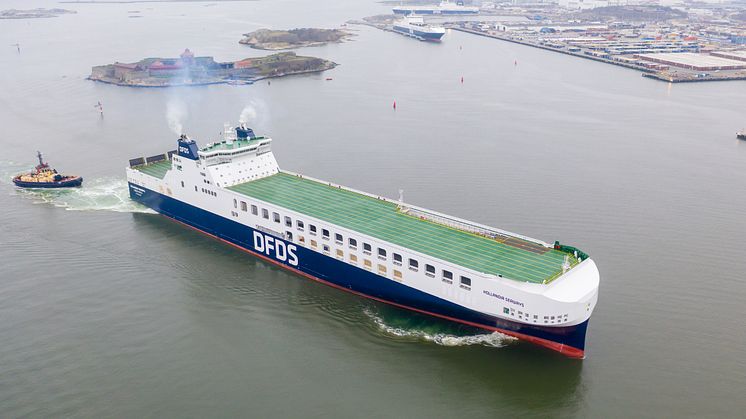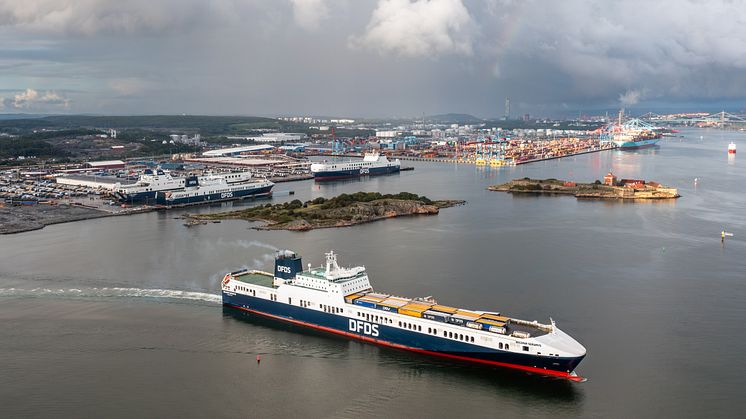
Press release -
DFDS increases capacity at the Port of Gothenburg with new vessel
DFDS is bringing a new vessel into service that will strengthen the port’s offering within the intra-European ro-ro sector. The newly built Hollandia Seaways is one of the largest ro-ro vessels in the world and will increase capacity to and from the Port of Gothenburg by over 600 trailers per week.
This newbuild, recently delivered from the Jinling Shipyard in China, is 237.4 m long and 33 m wide. It can carry up to 450 trailers, which if parked end to end would form a line 6.7 km long.
Compared with its predecessor, Petunia Seaways, the increase in capacity is around 50 per cent, and overall the new vessel is more fuel-efficient.
“Hollandia is part of the company’s sustainable investment agenda aimed at easing pressure on extremely busy roads and reducing the impact of shipping on our oceans,” said Morgan Olausson, DFDS Seaways chief executive.
Large volumes between Gothenburg and Belgium
2018 was the ninth year in succession that traffic increased on the routes between Gothenburg and the Belgian ports of Ghent and Zeebrugge. During that period, volumes to Belgium doubled and the number of departures rose from 12 to 16. Apart from DFDS, the shipping companies CLdN and EML also operate between Belgium and Gothenburg.
“The cargo transported between the countries includes vehicles, industrial components, steel and forest products, all of which are in high demand,” said Jacob Minnhagen, Senior Business Development Manager at the Gothenburg Port Authority.
“The catchment area is substantial and covers the whole of the Benelux region, Germany and France. Many Swedish export goods are transshipped at our Belgian ports for onward transport to other European markets. The first-rate service, capacity and frequency offered by the shipping companies to these markets have proved to be key success factors,” said Jacob Minnhagen.
Landside meeting point
The Gothenburg Port Authority has also embarked on an extensive investment programme at the Port of Gothenburg. The Arken Combi Terminal, located directly beside the Ro-Ro Terminal, is already in operation and handles large volumes of rail and road freight which are transloaded onto ships.
In 2020, a completely new rail-connected crossdocking terminal – the Svea Terminal – will open. Large volumes of incoming forest products will be transloaded for onward transport by sea to the continent. There is also Arendal 2, which is taking shape directly beside the Ro-Ro Terminal and will ultimately add 220,000 square metres of new terminal space, as well as the logistics park that is emerging in the port’s hinterland, with a further one million square metres.
“We are working in the long term to meet the needs of the market and this is a puzzle we are piecing together in close collaboration with terminal operators, shipping companies, freight purchasers, the government, the city, and the rest of industry to ensure the Port of Gothenburg continues to be the natural freight hub in the Swedish transport system,” said Arvid Guthed, Vice President, Port Development at Gothenburg Port Authority.
Topics
Fact file: Port of Gothenburg
The Port of Gothenburg is the largest port in the Nordic region. 30 per cent of Swedish foreign trade passes through the Port of Gothenburg as well as half of all container traffic.
The Port of Gothenburg is the only port in Sweden with the capacity to receive the world's largest container vessels and has the broadest range of shipping routes within and outside Europe. The 25 rail shuttles that depart each day mean that companies throughout Sweden and Norway have a direct, environmentally smart link to the largest port in the Nordic region. The Port of Gothenburg has terminals for oil, cars, ro-ro, containers and passengers.


